12 Earthquake Design of Large Structures
“I don’t know. This looks like an unreinforced masonry chimney to me.”
Santa Claus, undated
“The building acted as it should. It’s really rewarding to know with the pains we took and the money we spent on behalf of the building, that it worked.”
Angi Davis, property manager of Starbucks Center in Seattle, constructed in 1912, commenting on the retrofit of the building prior to the Nisqually Earthquake
1. Introduction
It’s impossible to earthquake-proof a building. A look at the intensity scale (Table 3-1) shows that for intensities of IX and worse, even well-designed and well-constructed buildings can fail. However, most earthquakes have maximum intensities of VIII or less, and well-constructed buildings should survive these intensities. The highest intensity recorded in a Pacific Northwest earthquake was VIII in the 1949 Puget Sound Earthquake and locally on Harbor Island in Seattle in the 2001 Nisqually Earthquake. However, an earthquake on the Seattle Fault or the Cascadia Subduction Zone would have higher intensities.
Building codes should be designed so that a building will resist (1) minor ground motion without damage, (2) moderate earthquake ground-shaking without structural damage but possibly with some nonstructural damage, and (3) major ground motion with an intensity equivalent to the maximum considered earthquake (MCE) for the region (Chapter 7) without structural collapse, although possibly some structural damage. In this last case, the building could be declared a total loss, but it would not collapse and people inside could escape safely.
Upgrading the building code does not have an immediate effect on safety. Building codes affect new construction or major remodeling of large existing buildings; if a building is not remodeled, it will retain the safety standards at the time it was constructed. The greatest losses in recent California and Puget Sound earthquakes were sustained by old, and non-ductile reinforced concrete frames with and without unreinforced masonry walls. For example, forty-seven of the sixty-four people who died in the 1971 Sylmar Earthquake lost their lives due to the collapse of a single facility, the Veterans Administration Hospital (Figure 12-1). This was a reinforced-concrete structure built in the 1920s, before the establishment of earthquake-related building standards after the 1933 Long Beach Earthquake. The collapsed buildings were designed to carry only vertical loads. Figure 12-1 is an aerial view of the hospital campus immediately following the earthquake. The building in the photograph that held up well had been reinforced after the 1933 earthquake. Clearly, retrofitting paid off in terms of lives saved.

In the same vein, the greatest losses in Pacific Northwest earthquakes, including the 1949, 1965, and 2001 Puget Sound earthquakes (Figure 12-2) and the 1993 Scotts Mills and Klamath Falls, Oregon, earthquakes (Figure 6-25) were in old unreinforced masonry buildings, especially schools, which seem to take the longest time to replace.

It’s much more expensive to retrofit a building for earthquake safety than it is to build in the same safety protection for a new building. Typically, a simple structure will cost at least nine to ten dollars per square foot to retrofit. A nonductile reinforced concrete frame structure will be two to three times more expensive. The cost for a historic building could reach a hundred dollars per square foot. The owner of the building must consider the possibility that the money spent in upgrading might not be returned in an increased value of the building or increased income received from it, unless a change of use for the building is proposed.
It is for these reasons that it takes so long to upgrade the building inventory of a city . Owners of buildings in downtowns in the Pacific Northwest continue to rely on at-risk unreinforced masonry (URM) buildings for their economic livelihood, gambling that the expected great earthquake will not arrive any time soon.
Legislation can speed the process along. In 1986, the State of California passed a law requiring local jurisdictions to identify all potentially hazardous buildings and then adopt policies and procedures reducing or eliminating potentially hazardous conditions. After the 1989 Loma Prieta Earthquake and the 1994 Northridge Earthquake, the URM Law was passed in 1996 in the Bay Area, making it mandatory to retrofit URM buildings. This means that that part of the subduction zone in northern California is safer than the subduction zone farther north. It is only in 2015 that the City of Portland and Seattle are looking into developing policies for mandatory URM retrofits. If the unreinforced masonry (URM) building has historical value, the owner should consider having the building designated as a historic structure, opening up the availability of funds for retrofitting historic structures.
2. Seismic Retrofitting
The Starbucks Center occupies a nine-story building that was formerly a Sears catalog store constructed in 1912 on tidal fill next to Elliott Bay. Before Starbucks moved in, the City of Seattle required an earthquake upgrade costing $8.5 million. Nearly two thousand people were in the building when the Nisqually Earthquake struck. People dove under desks and tables. Rick Arthur, a Starbucks vice-president, said that “it felt like a typhoon coming through. … The floor rose in big waves. At first, we felt it was a fairly minor event, but it kept going and building in intensity. The lights were swinging in big arcs.” Some of the walls cracked, and a four-foot brick parapet on top of the building crashed to the ground. But everyone got out safely, and there were no injuries. Arthur said his first thought was, “Thank you, Terry,” referring to Terry Lundeen, a structural engineer with Coughlin Porter Lundeen, who managed the Starbucks retrofit. Money well spent.
Traditionally, the goal of seismic retrofitting, like the goal of building codes, has always been to allow people inside the structure to survive the earthquake. Damage control and protection of property are secondary, except for certain historic buildings, as discussed above. Recent concepts of performance-based earthquake engineering are placing greater emphasis on controlling property damage to avoid financial losses, including loss of business for a commercial building. Damage control is also important for critical facilities such as hospitals, police stations, and fire stations.

Brittle structures behave poorly during earthquakes. Unreinforced masonry that bears the structural load of a building with poorly tied floor and roof framing tends to fail by wall collapse. Nonductile concrete-frame buildings are subject to shear failure of weak, unconfined columns. Framed structures with large parts of their walls not tied together tend to behave structurally as soft-story structures (like the three-car garage in the San Fernando Valley shown in Figure 11-6). In recent earthquakes, including the 1994 Northridge Earthquake, these structures have failed catastrophically, with loss of life.
Strengthening of existing buildings must ensure that the added reinforcing is compatible with the material already there. For example, a diagonal steel brace might be added to a masonry wall. The brace is strong enough, but it would not carry the load during shaking until the masonry had first cracked and distorted. The brace can prevent total collapse, but the building might undergo enough structural damage to be considered a total loss. It is only recently that there are success cases of these retrofitted structures in California following the URM law and its implementation by local government. During the 2014 Mw6.0 South Napa Earthquake in California, many retrofitted and non-retrofitted buildings suffered damage. One year later, in August 2015, an important finding was made: even though retrofitted URM buildings had seen slight to moderate damage, most of these buildings were under repair; in contrast, most of the damaged non-retrofitted buildings were commissioned to be demolished after building owners considered them to be a total loss.
A test of the California URM Law came with the 2014 magnitude 6 South Napa Earthquake, in which both retrofitted and non-retrofitted buildings were damaged. In the following year, it was determined that even though retrofitted URM buildings had undergone slight to moderate damage, most of them were being repaired. In contrast, buildings that had not been retrofitted at the time of the earthquake were determined by their owners to be a total loss, and they were commissioned to be demolished.
Figure 12-3 shows several types of retrofit solutions for old buildings. The walls may be strengthened by infill walls, by bracing, by post-tensioning, by external buttresses (beautifully displayed by medieval Gothic cathedrals in western Europe), by adding an exterior or interior frame, or by base isolation. The building needs to behave as a unit during shaking, because the earthquake is likely to produce failure along weak joins.
There are several lateral force-resisting systems for withstanding the earthquake-induced forces, including moment resistant frames, shear walls, and braced frames, for example. In addition, the lateral-resisting system may be a combination these systems. These lateral-resisting systems can be constructed out of reinforced concrete, structural steel, reinforced masonry, or even timber. At the floor levels, the lateral resisting forces are transferred through a diaphragm.
The term diaphragm is used for a horizontal element of the building, such as a floor or a roof, that transfers horizontal forces between vertical elements such as walls or columns (Figure 12-4a). The diaphragm can be considered as an I-beam, with the diaphragm itself the web of the beam and its edges the flanges of the beam (Figure 12-4b). In most buildings, holes are cut in the diaphragm for elevator shafts or skylights (Figure 12-4c). These holes interrupt the continuity and thereby reduce the strength and stiffness of the diaphragm (Figure 12-4d).
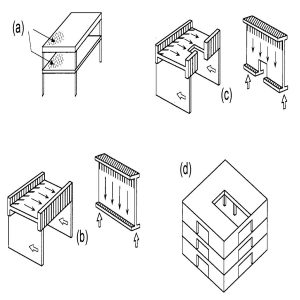
Lateral forces from diaphragms are transmitted to and from the ground through shear walls or moment resisting frames. The forces are shear forces, those tending to distort the shape of the wall, or bending forces for slender structures like a skyscraper (Figure 12-5). Construction may include walls that have higher shear strength or diagonal steel bracing, or both.
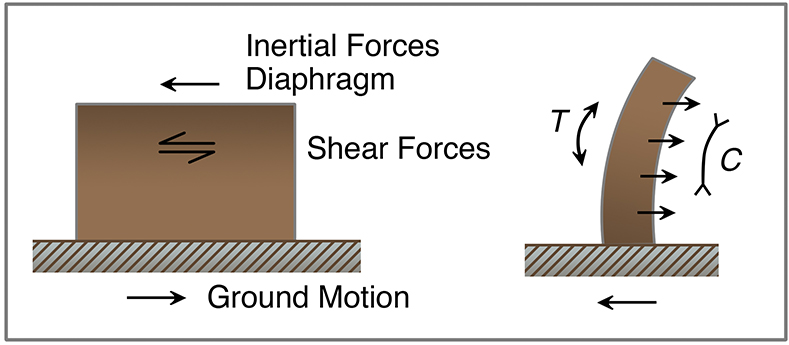
Moment-resistant frames are more flexible than shear-wall structures; they are less likely to undergo major structural damage but more likely to have damage to interior walls, partitions, and ceilings (Figure 12-6). Several steel-frame buildings failed in the 1994 Northridge Earthquake, but the failures were in large part due to poor welds at the joints—a failure in design, construction, and inspection.
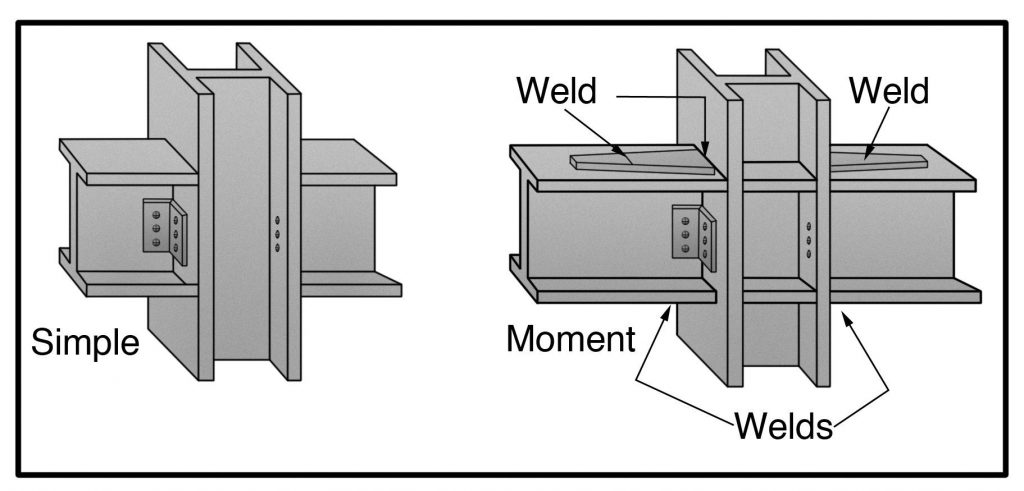
3. Base Isolation
The normal approach to providing seismic resistance is to attach the structure firmly to the ground. All ground movements are transferred to the structure, which is designed to survive the inertial forces of the ground motion. This is the reason why your house is bolted to its foundation and your cripple wall is reinforced.
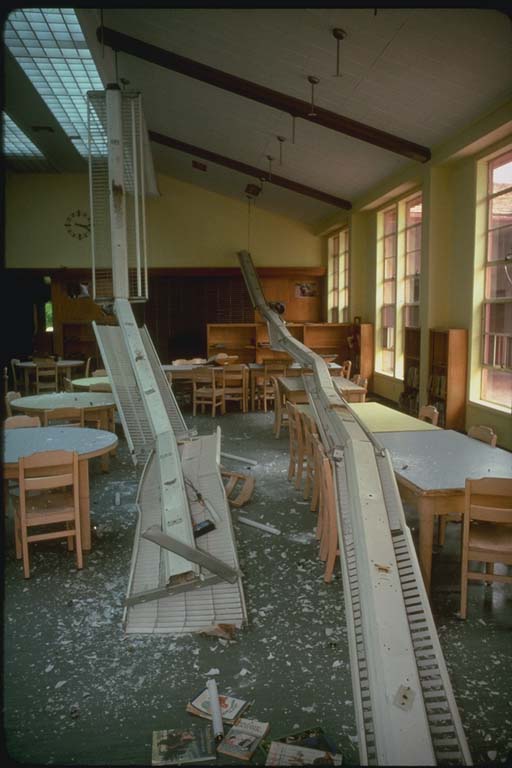
In large buildings, these inertial forces can exceed the strength of any structure that has been reinforced within reasonable economic limits. The engineer designs the building to be highly ductile, so that it will deform extensively and absorb these inertial forces without collapsing. Moment-resistant steel-frame structures are good for this purpose, as are special concrete structures with a large amount of steel reinforcing.
These buildings don’t collapse, but, as stated above, they have a major disadvantage. In deforming, they can cause extensive damage to ceilings, partitions, and building contents (Figure 12-7) such as filing cabinets and computers. Equipment, including utilities, will stop operating. High-rise buildings will sway and might cause occupants to become motion-sick and panicky. In addition, staircases may fail, hindering evacuation of the building after an earthquake.
The problem with attaching the building firmly to the ground is that the earthquake waves are absorbed by the building and its contents, often destructively. Is there a way to dissipate the energy in the foundation before it reaches the main floors of the building?
In base isolation, the engineer takes the opposite approach: the objective is to keep the ground motion from being transferred into the building. This is the same objective as in automobile design—to keep the passengers from feeling all the bumps in the road. To accomplish this, the automobile is designed with air-inflated tires, springs, and shock absorbers to keep its passengers comfortable.
One way to do this is to put the building on roller bearings so that as the ground moves horizontally, the building remains stationary (Figure 12-8). A problem with this solution is that roller bearings would still transmit force into the building through friction. In addition, once the building began to roll, its inertia would tend to keep it moving. We need a structure that allows horizontal movement with respect to the ground, but restrains, or dampens, this movement so that as the ground vibrates rapidly, the building vibrates much more slowly with slower velocities and accelerations.

The solution is to separate the requirement for load bearing (vertical loads) from that for movement (horizontal loads). One way to do this involves a lead-rubber bearing (Figure 12-9). This bearing consists of alternating laminations of rubber and steel, which allow for up to six inches of horizontal movement without fracturing but are strong enough to support the building. A cylindrical lead plug is placed in the center of this bearing to dampen the oscillations in the ground produced by an earthquake, just like the shock absorbers in a car. The energy of the earthquake waves is absorbed by the lead plug rather than by the building itself. The lead plugs do not deform in small earthquakes or high winds; in that respect, they serve as “seismic fuses.”
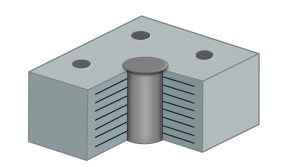
Lead recovers nearly all of its mechanical properties after each deformation from an earthquake. This is analogous to the solid-state ductile deformation of lower crustal rocks without producing earthquakes. The lead-rubber bearings allow the ground under a building to move rapidly, but the building itself moves much more slowly, thereby reducing accelerations and maximum shear forces applied to the building. The building is allowed to move about six inches horizontally. A six-inch slot around the building is built for this purpose and covered by a replaceable metal grating. The damage to architectural and mechanical components of the building, and the ensuing costly repairs, are greatly reduced and, in some instances, almost eliminated.
There are some new systems, which go beyond the lead-bearing base isolator. Examples are the single and triple pendulum bearing systems. The single pendulum system maintains constant friction, lateral stiffness, and dynamic period for all levels of earthquake motion and displacements. The triple pendulum system includes three pendulum mechanisms that are sequentially activated as the earthquake motions become more intense.
Although base isolation adds to the cost of construction, some cost savings are possible within the building itself because so much of the earthquake force is absorbed at the base of the building rather than transmitted into the structure.
The Pioneer Courthouse in Portland, constructed in 1875, is the oldest surviving federal building in the Pacific Northwest, and it has been designated a National Historic Landmark. It houses the Ninth District Court of Appeals. The challenge of a seismic retrofit of this unreinforced-masonry building was to strengthen the building without totally disrupting its character, including its sandstone-block walls. The solution was base isolation, installed below the existing foundations of the building, which minimized construction in the historic sections of the structure. The retrofit was completed in 2005.
Research is underway in Japan, New Zealand, and the United States to design other methods of base isolation and other ways to dissipate seismic energy in a building. After the 1989 Loma Prieta Earthquake, the California State Legislature passed Senate Bill 920, requiring the state architect to select one new and two existing buildings to demonstrate new engineering technologies, including base isolation. The new international airport terminal in Istanbul, Turkey, is the largest base-isolation building on Earth.
4. Special Problems
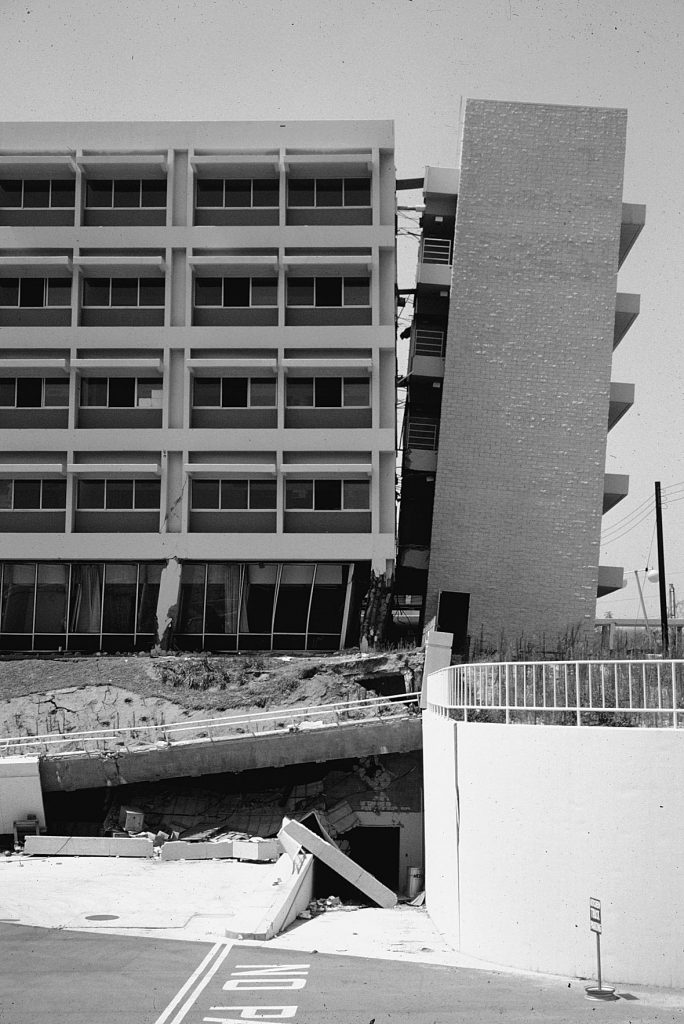
Each large building presents its own set of design problems in surviving earthquake forces, which means that architects must consider earthquake shaking in designing a large structure in a seismically hazardous region such as the Pacific Northwest. I consider the problem of a soft ground floors and the issue of the tuning fork.
In a building with a soft ground floor, the ground floor is weaker than the higher floors. The ground floor is taken up by a parking garage or contains large amounts of open space occupied by a department store or hotel ballroom. Instead of load-bearing walls, these spaces are supported by columns. Building codes commonly limit the height of soft stories to two normal stories, or thirty feet. But the result is that the ground floor is less stiff (has less strength) than the overlying floors. Since earthquake forces enter the building at its base and are strongest there, the soft ground floor is a “strength and stiffness discontinuity” that absorbs the force of the earthquake waves. Without a soft ground floor, the earthquake forces are distributed more equally throughout the entire building. With a soft ground floor, there is a tremendous concentration of forces on the ground floor and at the connection between the ground floor and the second floor. This can cause collapse or partial collapse of the higher floors, as happened at the Los Angeles County Olive View Medical Center during the 1971 Sylmar Earthquake (Figures 12-10 and 12-11). The upper floors were relatively undamaged, but the lowermost floor and basement absorbed much of the force. The acceleration came from the right, and the building was forced toward the right, almost knocking down the stairwell. The problem can be alleviated by adding more columns, stiffening the existing structure. A second problem is illustrated by Figure 12-12, in which apartments were constructed over a garage in the basement, which acted as a soft story.
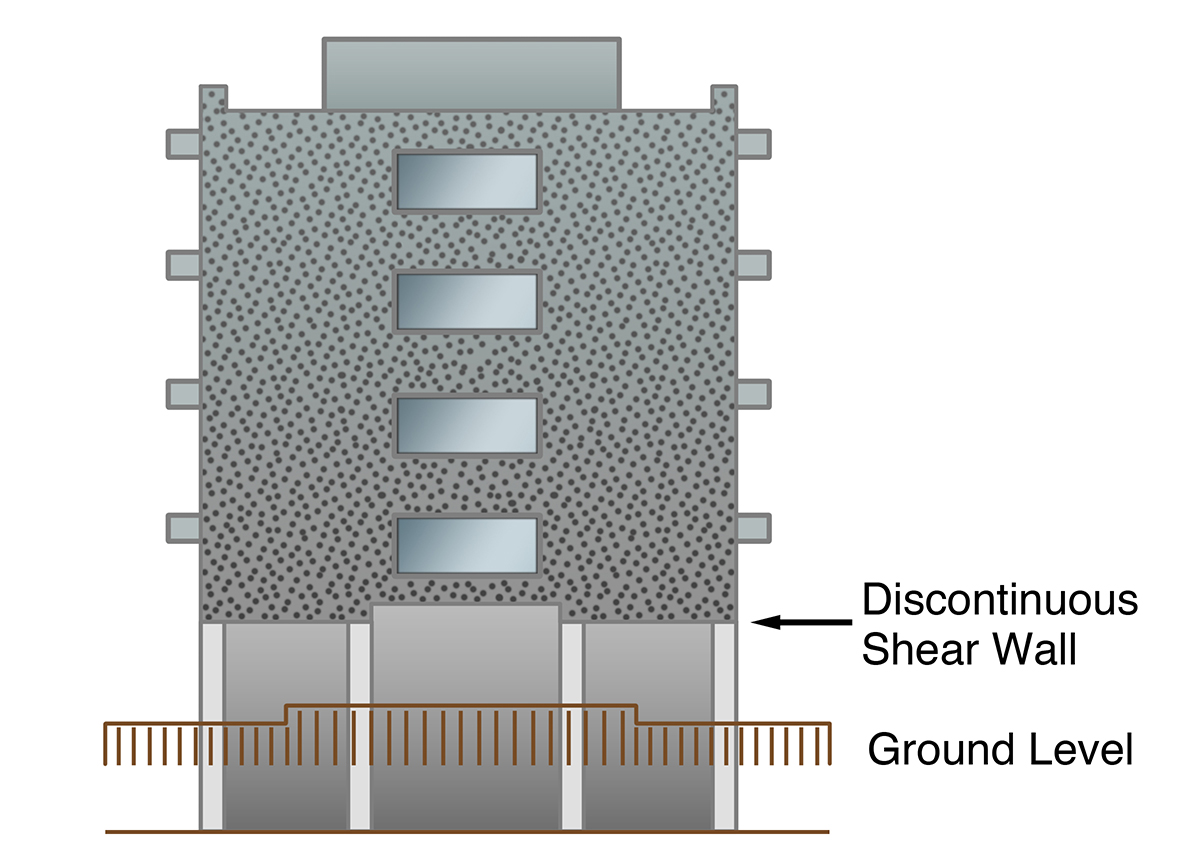
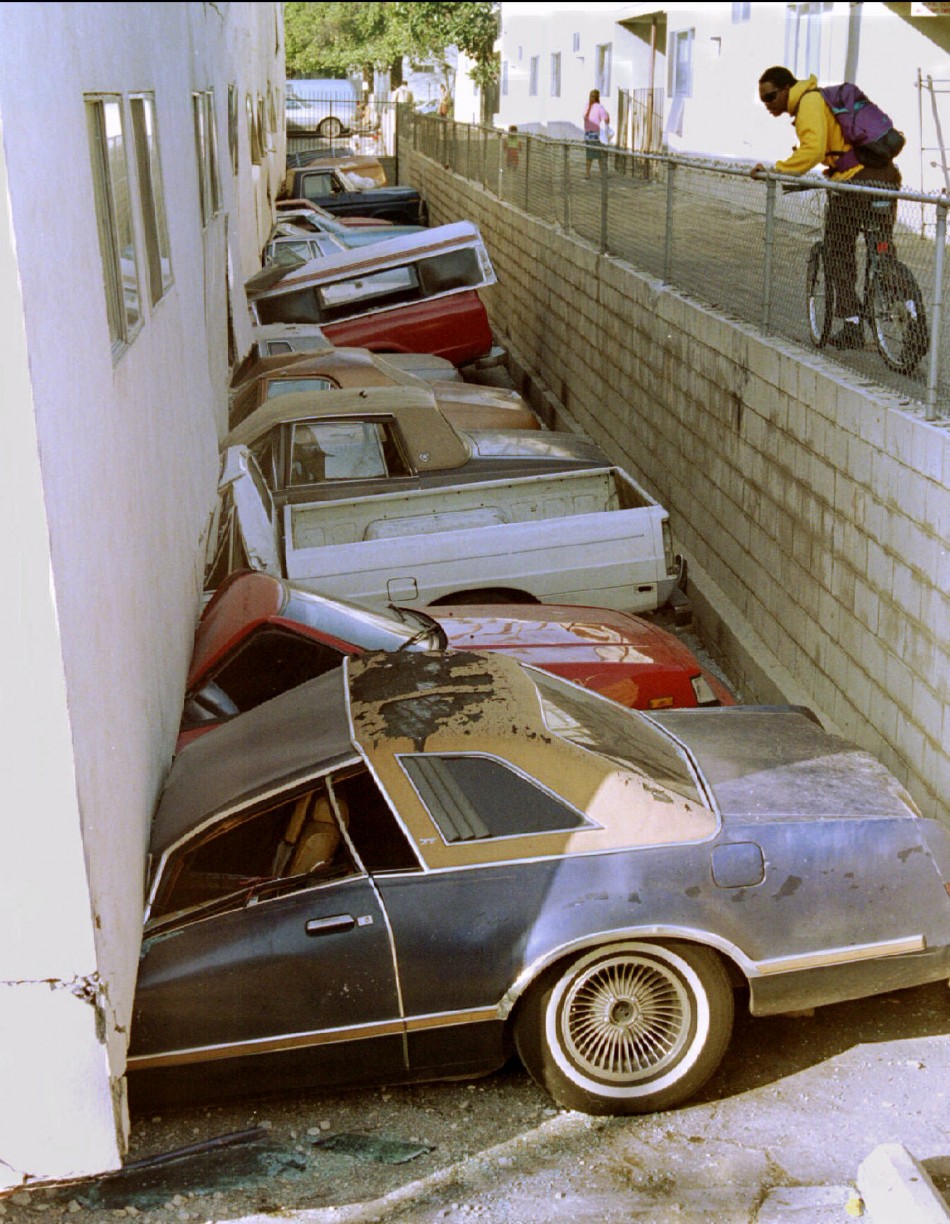
This brings us to the tuning fork problem. A large pipe organ has pipes of different lengths so that the organ can play different notes. The deep bass notes are played on long pipes, and the high notes are played on short pipes. A xylophone works the same way: the high notes are played on short keys, and the low notes are played on long keys. These instruments are designed to take advantage of the vibrational frequency of the pipes or keys to make music. A tuning fork works in the same way. Strike the tuning fork and place it tines-up on a hard surface. You will hear a specific note, related to the length of the tuning fork, which generates sound waves of a specific frequency—the vibrational frequency of the tuning fork.
I recall a TV commercial in which a wine glass is shattered when a Wagnerian soprano sings a certain high note. Buildings work in the same way. A tall building vibrates at a lower frequency than a short building, just like a tuning fork. The problem comes when the earthquake wave transmitted through the ground vibrates at the same frequency as the building. The building resonates with the earthquake waves, and the amplitude of the waves is intensified. All other things being the same, a building with the same vibrational frequency as the earthquake waves will suffer more damage than other buildings of different height.
In the Mexico City Earthquake of 1985, surface waves with a period of about two seconds were amplified by the soft clay underlying most of the city, which also extended the period of strong shaking. Buildings between ten and fourteen stories suffered the greatest damage, because they had a natural vibrational period of one to two seconds (Figure 12-13). When waves of that characteristic frequency pushed the foundations of those buildings sideways, the natural resonance caused an accentuation of the sideways shaking and resulted in great structural damage. In contrast, a thirty-seven-story building built in the 1950s, with a vibrational period of 3.7 seconds, suffered no major structural damage.
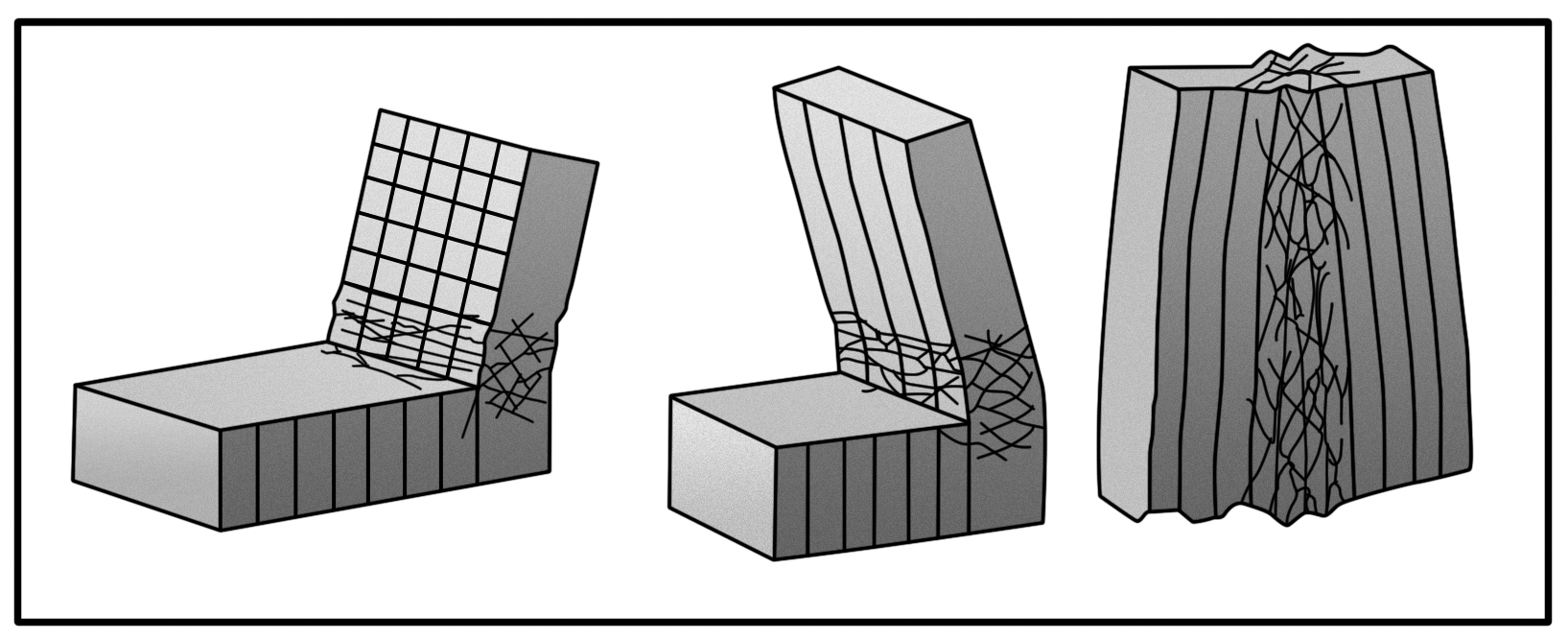
5. Bridges and Overpasses
Freeways and bridges are lifelines, and their failure can disrupt the economy and kill people on or beneath them during an earthquake (Figure 12-14). The television images of people sandwiched in their cars in the collapse of the double-decker Interstate 880 Cypress Viaduct in Oakland, California, the collapsed span of the Oakland-San Francisco Bay Bridge, and the pancaked freeway interchanges in Los Angeles after the Sylmar and Northridge earthquakes were dramatic reminders of the vulnerability to earthquakes of highways and railroads. Structural engineers in the Bridge Division of the Oregon Department of Transportation visited the collapsed freeway overpasses after the Northridge Earthquake, and their recommendations led to the first thorough appraisal of the earthquake potential of Oregon faults. However, most of the overpasses on Interstate 5 have not yet been repaired. As pointed out above, the 2015 Oregon Legislature failed to pass a transportation bill that would have begun retrofitting seismically-dangerous bridges that, if they failed, would cut off the Oregon coast from the Willamette Valley in a subduction-zone earthquake. The resilience survey pointed out the problem, but the legislature did nothing about it.
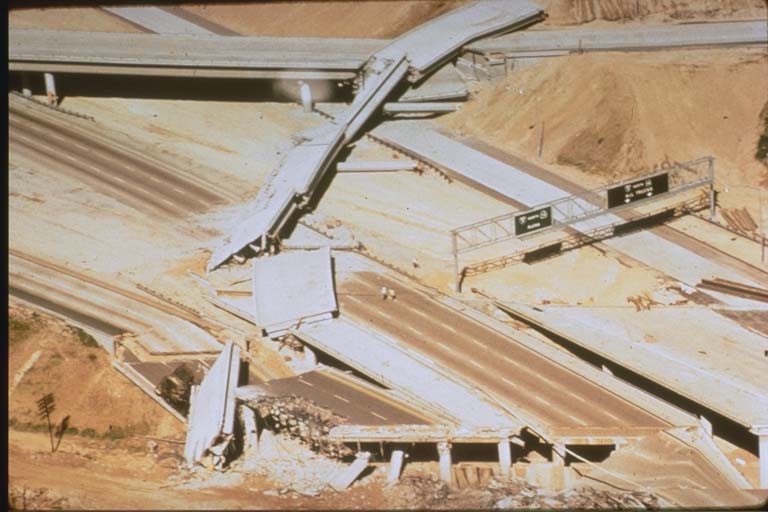
The double-decker Cypress Viaduct is reminiscent of the Marquam Bridge in Portland (since retrofitted) and the Alaskan Way Viaduct in Seattle, built in 1953 for $8 million on liquefiable soils. The Alaskan Way Viaduct was damaged in the 2001 Nisqually Earthquake and was closed for a time. Many people feared that if the shaking had lasted longer or had been of higher intensity, the viaduct would have collapsed. The Alaskan Way Viaduct is now being replaced. On the other hand, twenty-three bridges in Seattle had been retrofitted before the earthquake, and none of those were damaged.
Freeway collapses during the Northridge Earthquake caused great disruption to commuters traveling from northern and western suburbs to downtown Los Angeles. Failure of the Golden Gate Bridge and Bay Bridge could isolate San Francisco from counties north of the Bay and from East Bay cities. Bridge collapses on Highway 101 on the Oregon and Washington coast from the next subduction-zone earthquake could isolate coastal communities for an indefinite period of time, as concluded in the recent resilience surveys in both states.
Five bridges collapsed in the 1994 Northridge Earthquake. All were designed to pre-1974 standards, and none had been retrofitted. The Santa Monica Freeway had been targeted for seismic retrofit, but the earthquake got there first. In some cases, a collapsed bridge was adjacent to a recently retrofitted bridge that suffered little or no damage, even though it had been subjected to earthquake forces similar to those endured by the bridge that collapsed. Clearly, retrofit worked for bridges and overpasses.
The problem in the older bridges was in the columns supporting the freeway superstructure. There was inadequate column confinement, inadequate reinforcement connections between the columns and the footings on which they rested, and no top reinforcement in the footings themselves. When these problems were overcome in retrofitting, bridges rode through earthquakes fairly well.
California, through Caltrans, is the nation’s leader in the seismic retrofit of bridges. In 2000, Caltrans estimated that about seventeen hundred bridges in the state—about 10 percent of California’s bridges—required retrofit to prevent collapse during a future strong-motion earthquake. In the Pacific Northwest, bridges such as Interstate 5 and Interstate 205 across the Columbia River and the Tacoma Narrows bridge require special consideration, because a collapse could drop a large number of vehicles and passengers into the water. The cost of retrofitting all of these bridges is prohibitive if done in a very short period of time, but both Oregon and Washington have begun the process. The resilience surveys in both states revealed that a majority of bridges in Oregon and Washington are obsolete and are subject to collapse in the forthcoming Cascadia Subduction zone earthquake. This information has been transmitted to the legislatures that authorized the surveys, but funding to fix the problem has not yet been authorized.
Which bridges to retrofit first? Establish priorities based on the potential magnitude of the loss, both directly in damages and lives lost and in economic losses, then allocate the resources to do the job.
6. Engineering Against Ground Displacement
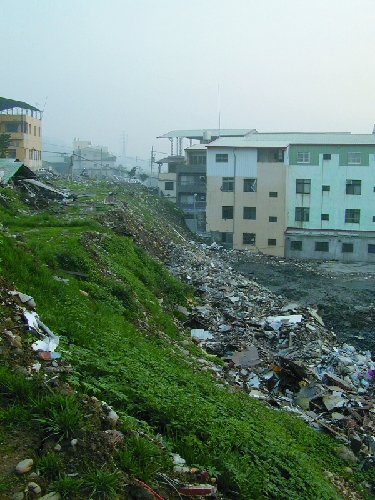
Up to this point, the main hazard discussed has been ground shaking. The Alquist-Priolo Act in California seeks to avoid construction on active fault traces (see chapter 14 for details). A large displacement of several feet, particularly vertical (dip-slip) displacement, will probably destroy a building constructed across the fault, but building foundations can be designed to survive displacements of a foot or less. It makes no difference whether the displacement is caused by faulting, ground subsidence, or incipient landsliding. An example of building destruction in Fengyuan City due to the 1999 Chi-Chi, Taiwan, earthquake is shown in Figure 12-15. The upthrown hanging wall is to the left, and footwall is to the right. The fault itself is close to the base of the scarp. Buildings along the hanging wall of the Chelungpu fault were totally destroyed.
Pipelines can be made flexible, and underground utility cables can have slack built in at fault crossings. The Trans-Alaska Oil Pipeline was built across a major strike-slip fault that underwent several feet of displacement in an earthquake in November 2002. After a paleoseismic study led by Lloyd Cluff of Pacific Gas and Electric Co., the pipeline was designed to accommodate strike-slip surface displacement. It survived the earthquake virtually undamaged and with no spillage of crude oil.
I recently served as a consultant on a housing development where there was potential for small-scale, distributed faulting on a large part of the property. The likelihood of a surface-rupturing earthquake was present but relatively low. The geologist determined the maximum amount of displacement expected based on backhoe excavations, and the geotechnical engineer (Jonathan Bray of the University of California Berkeley) designed building foundations that would withstand that displacement without significant damage.
7. Decisions, Decisions, and Triage
The astronomical cost of retrofitting bridges brings up a major problem faced by society. As you look at the building inventory in your town or the bridge inventory in your state, you soon recognize that in this era of budget cutbacks in government, the money is not available to retrofit even a sizeable percentage of the inventory. Decades will pass before dangerous buildings are retrofitted, with the retrofit decision commonly based on criteria other than earthquake shaking. When faced with a recommendation by two select committees to schedule the retrofit of dangerous buildings in Oregon, even over a time frame of many decades, the 1997 Oregon legislature did not act. However, a subsequent legislature passed Senate Bills 14 and 15 requiring that educational facilities from K-12 to public universities and emergency facilities, including hospitals and fire and police stations, be seismically strengthened by the year 2032. A preliminary evaluation was completed in 2007. In 2002, Oregon voters passed ballot measures to authorize the legislature to issue bonds to finance the construction required by these two bills. More recently, the Portland Public School District, the largest in Oregon, passed a bond issue with funds to retrofit old school buildings. If that work is completed before the next earthquake, children’s lives will be saved. I return to this topic in the last chapter.
The decision on what to retrofit is a form of triage. In a major disaster involving hundreds of severely injured people, limited medical aid requires decisions to help first those people who are more likely to survive. In earthquake retrofitting, the triage decision would be made to first retrofit those buildings that are most critical to the community, especially in an emergency, or structures whose destruction would be catastrophic to the population. These structures are called critical facilities. Let’s consider the second category first.
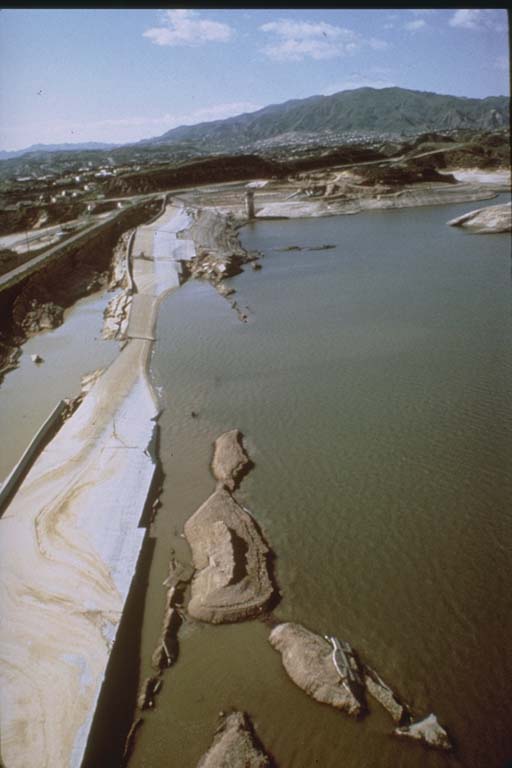
In Chapter 6, mention was made of the nuclear reactor at the Hanford Reservation in eastern Washington. Catastrophic failure of the reactor might result in the release of lethal amounts of radioactive gases and liquids, endangering the lives of hundreds of thousands of people, including those living downstream in Portland. Clearly, the Hanford nuclear reactor and stored nuclear wastes are critical facilities; they must be designed to meet the highest seismic design criteria even if the time of the next earthquake is not known. The large dams on the Columbia River are also critical facilities. If a dam failed during an earthquake, it would release enormous volumes of water from the reservoir impounded behind it. These dams must be designed to withstand the highest conceivable amount of seismic shaking. The Van Norman Dam in the San Fernando Valley of California came very close to failure during the M 6.7 Sylmar Earthquake in 1971 (Figure 12-16). Had failure occurred, the waters impounded behind the dam would have overwhelmed many thousands of homes downstream, resulting in the loss of thousands of lives. It was an incredibly close call.
Continuing with our triage dilemma, what facilities in your town must continue to operate after an earthquake? Certainly the command structure of local government must function, because local government leaders will direct rescue efforts and make decisions that could avert spin-off disasters that can accompany an earthquake, such as major fires and tsunamis. So we should include the police and sheriff’s departments, the fire department, city hall, and the county building, including the office of county emergency management services.
How about hospitals? Several hospitals were severely damaged in 1971 (Figures 12-1 and 12-10), and injured people had to be transported to distant hospitals that had not been damaged. Schools? Most of the school children of Spitak and Leninakan, Armenia, were in their classrooms when the 1988 Spitak Earthquake struck. The classrooms were in poorly constructed, Soviet-era unreinforced-concrete buildings that collapsed, killing most of the pupils and teachers inside. There is a five- or six-year age gap in those communities in Armenia; most of the young people of that age were killed in the earthquake.
School buildings fared badly in the 1933 Long Beach Earthquake because so many of them were unreinforced brick buildings. It was providential that there were no children in those buildings at the time of the earthquake. Had the classrooms been full, hundreds of children might have died here also. This fact became obvious to parents after the Long Beach Earthquake, leading to passage of the Field Act requiring earthquake standards for school buildings. As a result, most school buildings in California have already been replaced or recycled.
Seattle, Washington, and Portland, Eugene, and Corvallis, Oregon, have passed major bond issues to bring school buildings up to modern building codes. The Seattle School District had completed a retrofit of its aging school buildings the year before the Nisqually Earthquake. After the earthquake, District Superintendent Joseph Olchefske remarked that “Our buildings today are as secure as they could be. If this had occurred five years ago, we could have had very different vulnerabilities.”
Acknowledgements
I am not an engineer, and I am indebted to my colleagues in the College of Engineering for reviewing this chapter. The first edition was reviewed by Tom Miller and Steve Dickenson, and the third edition was reviewed by Andre Barbosa. Any mistakes are mine.
Suggestions for Further Reading
Bozorgnia, Y., and V. Bertero, editors. 2004. Earthquake Engineering: From Engineering Seismology to Performance-Based Engineering. Boca Raton, FL: CRC Press. Summary articles by leading experts in the field.
Chen, W.-F., and C. Scawthorn, editors. 2003. Earthquake Engineering Handbook. Boca Raton, FL.: CRC Press, 1,512 p.
Earthquake Engineering Research Institute. 1996. Construction quality, education, and seismic safety. Oakland, CA: Earthquake Engineering Research Institute, EERI Endowment Fund White Paper, 68 p.
Fratessa, P. 1994. Buildings: Practical Lessons from the Loma Prieta Earthquake. Washington, D.C.: National Academy Press.
Krinitsky, E., J. Gould, and F. Edinger. 1993. Fundamentals of Earthquake Resistant Construction. Wiley Series of Practical Construction Guides. New York: J. Wiley & Sons.
Lagorio, H. J. 1990. Earthquakes: An Architect’s Guide to Nonstructural Seismic Hazards. New York: J. Wiley & Sons.
Manolis, G. D., D. E. Beskos, and C. A. Brabbia. 1996. Earthquake Resistant Engineering Structures. Computational Mechanics, 728 p.
Naeim, F., ed., 2001. The Seismic Design Handbook. 2nd Edition. Kluwer Academic Publishers.

